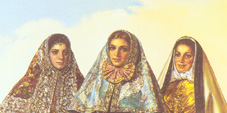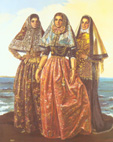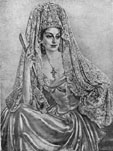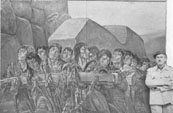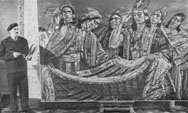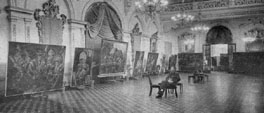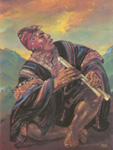Kristian Kreković
(likovne kritike)
Krekovic with his Balear girls
Pogledajmo neke misli likovnih kritičara o djelu Kristiana Krekovića:
Manuel Vegas Castillo, Odjel kulture Peruanskog ministarstva obrazovanja:
Kristian Kreković, the Croatian-born artist, has dedicated his life and his Art to the fabulous Empire of Inkas, Pre-Inkas and present day Hispano-American Folklore, with such prodigality of love and truth, art and knowledge, force and sensuality, sacrifice and perseverance, the likes of which have never been equalled by any other painter in the artistic history of America.Over the long years when I had the honor of directing and guiding the culture of my country, I have been able to observe the superhuman efforts made by Kreković who visited museums all over the wolrd to study the New World archaic cultures and to paint in their collections the precious textiles, pre-Columbian jewels and adornments for his paintings. I was also an exceptional witness to his expeditions in the native regions of the Andes to heights around 10.000-12.000 feet [3-4.000 meters], in order to seek out and paint the purest and most representative types of the Aboriginal race, there on the spot.
Three Balear girls
(Mallorca, Menorca, and Eivissa)The splendid Kreković collections enjoys its great prestige because it is the only in the world which presents the Art and Culture of the South American Indian that legendary bronze race of the Inkas, with such astonishing and brilliant results, excellence in picturing, strongest historical and scientific authenticity, creative imagination and magnificent interpretation. The whole undertaken and realized by one single man. This explains the enormous success, endorsed by the critics, which his exhibitions have enjoyed in the most important cultural centres of Europe and U.S.A.
Kreković's paintings are such expressive compositions, and almost threedimensional. His brush-strokes are definitive, his colouring luminous. He cannot be classed among any existing Schools, he is quite unique and apart. His Peruvian work has no equivalent, and occupies a special place, not only in the artistic history of Peru, but in the Art of all time. Nobodey can visit his collection without being profoundly impressed by it.
For his artistic merits the Peruvian Governemnt has granted Mr. Kreković the "Order of Merit for distinguished Services" and furthermore the President of the Republic of Peru has patronised his exhibitions all over world, a most exceptional distincion.
Some of the 2,300 opinions about his Peruvian work exhibited in the City Hall of Lima, under the patronage of the President of the Republic of Peru, who inaugurated personally the Exposition (visited by 20,000 people in five weeks), and decorated Krekovic with the Order of Merit for Distinguished Services (from [here], photos below are from the accompaning booklet Kristian Krekovic, Fabulous Peru):
- Krekovic, you have given force, beauty, vigor and dignity to our race, past and present. Thank you. (José Etcheverya)
- What magnificent quality in painting, what forcefulness in interpretation, what technical power, and what a profound knowledge of our indigenous civilisation! (E. Jimenez Prado)
- To the great painter, extraordinary interpreter of the indigenous race of Peru, Mr Kristian Krekovic, with my whole-hearted admiration. (Dr. Santiago Antunez de Mayolo, Dean, Chemical Faculty, San Marcos University, Lima)
- Admirable exhibition for its gradeur, forcefullness and truth. (Jehan Vellard, professor, San Marocs University, Lima)
- Truly marvelous paintings; I might say that a new Michelangelo has come to Peru, to idealize the legendary race of the Incas. My congratulation for the authentic exposition of Peruvian people. (J. Becerra bravo)
- We born Peruvians, and we who feel we are Peruvians, are not only enchanted but thankful for the magnificent interpretation exemplified in the paintings herewith exhibited. (Rafael Aguilar - Senator)
- Never has Lima, nor elsewhere, seen an exposition of such force, magnitude and truth, undertaken by one single person. Gigantic workmanship in every sense! (Pedro Cardenas Mora)
- Krekovic, the impressive force of your Peruvian paintings, makes us vibrate with emotion. You have become immortal, just as it is the case with the marvelous stone work of the Incas of Cuzco. A sincere admirer of your art. (Ciceron Cabrera)
- What a grand work you have undertaken, Mr. Krekovic, worthi of the sincerest thanks and appreciation of the Peruivans, In your paintings you have expressed the force of the race, noble and great, just as your paintings are. (Alfons Carbajal R.)
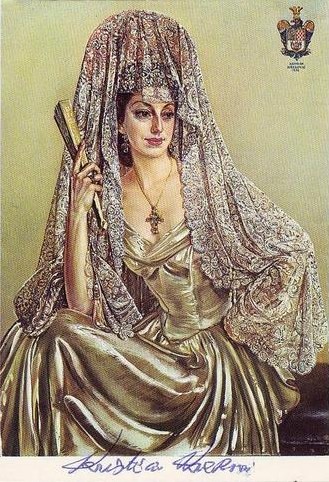
One of Krekovic's works of art exhibited in 1954 in the City Hall in Lima, now in Palma de Mallorca (this is a post card). Note a Croatian coat of arms on the top right, together with Bosnian lilly left of it and Peruvian coat of arms below them, which constitute Krekovic's personal coat of arms.
Estaban de Arteaga: Exhibition of paintings by Kristian Krekovic (article in "Cultura Peruana", April 1954, Lima):
A magnificent spectacle was revealed when the doors to the exhibit rooms were opened to the public. Enormous canvasses caught the eye first. They contained the monumental figures of our early Indian cultures and furnished the background for this exposition. The artist has used his gorgeous palette to portray in magnificant style the exotic types on canvas. As a consequence, the pictures reveal a precious artistic touch which the painter conveys with reference to the early races of our nationality, and he has proved to be highly successful in displaying these exalted types officially in the salons of the City Hall.
The Indians are painted in relation to their environmenthigh Andean plateau, etc. Krekovic endows their features with that same cyclopic dimension and grandeur in giving his characters a similar telluric characteristic. As a logical consequence he has given them forcefullness and orgiastic variety at the same time.
the monumental characteristic of these types is absolute and it is not necessarily the quantitative aspect which reveals this feature, nor is it the cordial tones depicted in the paintings; rather it is due to the use of color-shades of gold, green and blue - used in such masterly profusion and expressive fashion, that give us the enigmatic ensemble of our primitive races.
Hombres de Paracas
PARIS; Camille Mauclair, 1938.
LIMA: Jehan Vellard, Professor San Marcos University, 1954.
"...Admirable exhibition for its grandeur, force and truth..."
NEW YORK; "The American Artist", Thomas Beggs, Director of Fine Art Collection of the Smithsonian Institution, 1955.
"...The golden brush of Kristian Kreković. - The fine Krekovic exhibition of Peru is monumental. Glittering gold and the flashing brillance of blues and reds enliven with splendour his scenes of Peruivan Past and Present. In Washington a total of 126.066 visitors attended the exhibit..."
One reputable critic stated of Krekovic: "Native to
mountainous Croatia, where folk art and peasant craft have survived the
ebb and flow of military, political and religious tides for centuries,
he maintained a reverence for tradition and time-tested quality."
(Thomas M. Beggs, Director of the National Collection of Fine Arts,
Smithsonian Insitute, "The Golden Brush of Kristian Krekovic," American
Artist, Dec. 1955, 38.) Krekovic's exhibitions in Washington,
Philadelphia, Syracuse, and New York were significant events in
American art. [cited from Croatia - Land, People, Culture, Vol
II, Edited by Francis H. Eterovich, Christopher Spalatin]
Many thanks to Mr. Ivan Dubravcic for his kind
help. D.Z.
"The Washington Star", Flornece Berryman, 1955.
Jaume I., the first King of Catalonia
BOSTON
PHILADELPHIA
The syracuse Museum of fine Arts; Anna Wetherill Olmsted, Director, 1955.
"...We have been thrilled by these fabulous paintings of Peru, Past and Present in an exhibition which has aroused tremendous enthusiasm throughout the city, and has brought an unprecendented attendance to the Museum...".
El tocador de Quena
MADRID
BARCELONA; "La Vnaguardia Espanola": Juan Coretés, 1957.
"...as sensational, without any exaggeration, can be qualified the exhibition brought to us by the Croatian-born Peruvian artist Kristian Kreković. His, for the most part monumental paintings are masterly and complicated compositions, with absolutely perfect drawing, masterly treatment of chiaroscuro and brilliant and luminous palette...".
Indico con alpaca
Tekstovi preuzeti iz prospekta Kreković Collection (zahvaljujem g. Vladimiru Novaku na ustupljenim materijalima).
Es uno de los más grandes pintores de todos
los tiempos.
Camille Mauclair, [Gaspar Sabater,
str. 45-46]
Hrvatsko-peruanski slikar Kristian Kreković, Manuel Vegas Castillo, Direktor za Kulturu, povijest i arheologiju Ministarstva odgoja, Lima, Peru
Slikar Kristian Kreković i njegov muzej-zaklada, Manuel Alvarez de Sotomayor, ugledni knjižvenik i poznavatelj likovne umjetnosti, objavljeno u Hoya de Lunes, 28. kolovoza 1978. (posebno izdanje ponedjeljkom)
- Kristian Krekovic (engl.)
- Literatura
- Prekrasan triptih koji se nalazi u Anglikanskoj crkvi u Palma de Mallorki.
- Kristian Kreković (na hrvatskom)
- Kristian Kreković (na španjolskom)
- Kristian Kreković, crtice

